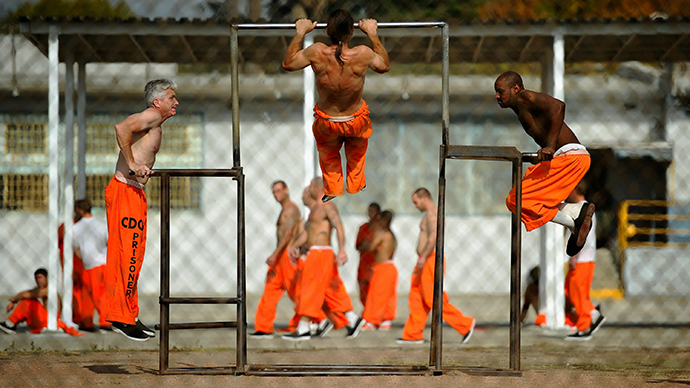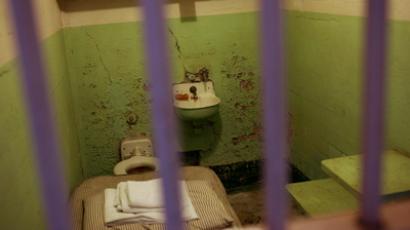Jail-breaking point: Overcrowded prisons strike White House clemency chord

The enormous outlay for overcrowded US federal prisons is forcing the White House to consider clemency and entreat non-violent, low-level felons serving terms for drug-related crimes to apply for early release.
Next week the US Bureau of Prisons will make the inmates aware of the six criteria elaborated by the US Justice Department for those who deserve early parole.
Those who want to go at large should conform to the following criteria: have a clean prison record, have no history of violence, possess no significant connections to gangs or other criminal organizations, and have at least 10 years served in prison.
First and foremost the amnesty is being prepared to repair injustice for those who would have received considerably shorter prison terms if they were put on trial today.
“These older, stringent punishments that are out of line with sentences imposed under today's laws erode people's confidence in our criminal justice system,” Deputy Attorney General James Cole told AP.
The matter is that back in 2010 the Fair Sentencing Act eliminated a five-year mandatory minimum for those accused of first-time possession of crack cocaine, a legal loophole that made excessive sentencing in drug cases possible for many years. But the FSA law had no retroactive effect, leaving about 9,000 low-level felons behind bars who were sentenced before 2010 for drug-related crimes.
Harsh penalties for drug offenders is an echo of the legal battle to constrain cocaine epidemic in 1980s, which resulted in disproportionately tough punishment for drug offenders.
Another peculiarity in the cocaine issue was that crack cocaine drug abusers were primarily black US citizens, whereas those who consumed the drug in powder form, had tendency to be mostly white. The crack smokers were usually convicted to longer prison terms.
“These defendants were properly held accountable for their criminal conduct,” Cole acknowledged, “However, some of them, simply because of the operation of sentencing laws on the books at the time, received substantial sentences that are disproportionate to what they would receive today.”
The new clemency criteria would be applied to inmates of solely federal prisons. A source cited by Cole estimated the number of such inmates as approximately 23,000.

Yet the situation in US state prisons is no good either, as the capacity of correctional institutions has been long since exceeded to a disastrous level.
For example, prisons in Nebraska are running at 155 percent of capacity as of the end of March 2014.
Prisons are also overpopulated in California, where courts have already ruled the authorities to reduce the number of prisoners to 137.5 percent of the originally intended capacity, but only by February 2016, when the state is obliged to have no more than 112,164 inmates in 34 correctional facilities.
Given the overwhelming excess of prisoners in the US federal penitentiaries, there is little wonder that the Justice Department's budget is bulging at the seams, as billions are spent on confinement of those who offended the law, even though many of them could only do wrong to themselves by drug abuse.
The Justice Department's allocation for the federal prison system increased from $5 billion in 2008 to $6.9 billion today. Of that total, $2.5 billion is meant for inmate programs such as drug treatment, ‘psychology services’, and $435 million for food services.
In a report last year the US inspector general warned of a “growing crisis” over prison expenditures that threatens other law enforcement priorities.
Activists from such organizations as Families Against Mandatory Minimums and the Sentencing Project believe that despite the narrowness of the new clemency criteria, it could help focus the attention of Congress on expanding legislation to cut short mandatory sentences for nonviolent drug-related crimes.
“It seems the Justice Department is doing what it can to help stem the tide of people going to prison in record numbers for absurd lengths of time,” told AP Julie Stewart, president of Families Against Mandatory Minimums. “It really is up to Congress to take the next step and change the number of mandatory sentencing laws,” she said.
Prisonland
The number of the prisoners in America sums up to a quarter of the world’s total, AP reports.
Starting from the late 1970s, the US prison population has been growing along with government spending. Today about one in 100 of Americans is serving time.
The number of Americans incarcerated in federal prisons throughout the country has increased by nearly 30 percent over the past 10 years, according to a new report by an investigative arm of Congress.
The US federal custody currently incarcerates about 216,000 inmates, at least half of whom ended up in prison for drug-related crimes.

These statistics also extend beyond drugs and offenders: one in 28 children in America has a parent serving time for drug trafficking.
That explains why the US Attorney General Eric Holder is advocating shorter prison sentences for less serious drug trafficking offenses. This could dramatically cut US federal prison spending and herald the beginning of a new justice system.
Today nearly half of the African-American men who grow up in the United States are arrested at least once by the time they hit their 23rd birthday, according to a new landmark study that set out to examine biases within the criminal justice system.
According to the latest reports from Global Research, the Center for Research on Globalization, there are approximately 2 million inmates in state, federal and private prisons throughout the US, most of the inmates are Black and Hispanic.
Many of the incarcerated are forced to work for various American industries “for a pittance.” They are paid some 25 cents an hour under threat of being locked in isolation cells.














